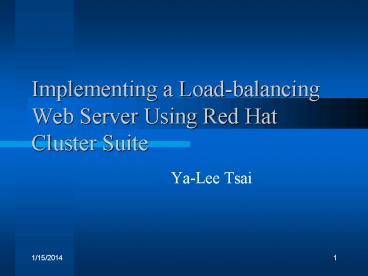Implementing a Load-balancing Web Server Using Red Hat Cluster Suite - PowerPoint PPT Presentation
Title:
Implementing a Load-balancing Web Server Using Red Hat Cluster Suite
Description:
Two Classes of Locally Distributed Architecture for Web Sites. Cluster-based web systems ... Www.redhat.Com/manuals/enterprise/RHEL-3-manual/cluster-suite ... – PowerPoint PPT presentation
Number of Views:317
Avg rating:3.0/5.0
Title: Implementing a Load-balancing Web Server Using Red Hat Cluster Suite
1
Implementing a Load-balancing Web Server Using
Red Hat Cluster Suite
- Ya-Lee Tsai
2
Project Goals
- Building a load-balancing web server
- Performance evaluation
3
Steps
- Setting up a working environment.
- Implementing load-balancing support in the
system. - Performance measurement and comparison.
4
Load-balancing Web Servers
- Balancing the load among the servers
- Providing
- High throughput
- High availability
5
Two Classes of Locally Distributed Architecture
for Web Sites
- Cluster-based web systems
- Virtual IP address
- Distributed web systems
- IP address visible to client applications
6
Architecture of A Cluster-based Web System
7
Architecture of a Distributed Web System
8
System Environment
- Web-serving cluster Linux cluster
- DBMS MySQL
- Benchmarks TPC Benchmark
9
Red Hat Cluster Suite
- A cluster of systems to provide highly available
web services, database servers, and other types
of services - Virtual web server configuration
- Using Linux virtual server (LVS) technology
10
A Basic LVS Configuration
11
MySQL Database Services
- Serve highly available data to applications.
- MySQL server packages are installed on each
cluster system that will run the service. - Database data is accessed by all cluster members.
12
TPC Benchmark
- TPC defines transaction performance and database
benchmarks. - TPC benchmarks measure transaction processing
and database performance in terms of how many
transactions a given system and a database can
perform per unit time.
13
TPC Benchmarks
- TPC-C -- OLTP
- TPC-H decision support for AD hoc queries
- TPC-W web e-commerce
- TPC-R decision support for business reporting
14
References
- IBM Research Report the State of the Art in
Locally Distributed Web-Server Systems, - Valeria Cardellini, Emiliano Casalicchio,
Michele Colajanni - Www.redhat.Com/manuals/enterprise/RHEL-3-manual/cl
uster-suite - Comparing the Memory System Performance of DSS
Workloads on the HP V-class and SGI Origin 2000, - Rong Yu, Laxmi Bhuyan, Ravi Iyer
- Building Clustered Linux Systems,
- Robert W. Lucke
15
- A Synthetic Streaming Workload Generator
Evaluation of Different Streaming Techniques - Reference GISMO A Generator of Internet
Streaming - Media Objects and workloads
- Shudong Jin and Azer
Bestavros - Boston University
- A preliminary version appears in ACM SIGMETRICS
Performance Evaluation Review, November, 2001
16
Workload Charateristics
- Session
- the service initiated by a user's request for a
transfer and terminated by a user's abortion of
an ongoing transfer. - Workload
- Session arrivals
- Properties of individual sessions
17
Session arrival
- Object Populariy
- zipf distribution
- a tendency for requests to be concentrated on a
few popular objects - Reference locality
- Heavy-tailed Pareto distribution
- Temporal proximity of requests to the same objects
18
Individual Session
- Object Size
- Lognormal distribution
- User interactivity
- Pareto distribution
- Object encoding characteristics
- Model the VBR auto-correlation of a streaming
object using a self-similar process - Use a heavy-tailed marginal distribution to
specify the level of burstiness of the bit rate
19
Streaming Architecture
20
Base server bandwidth requirments































